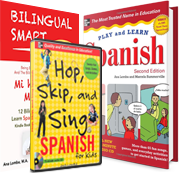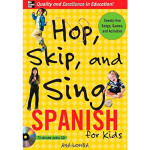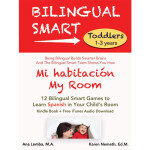 Many people make the mistake thinking that Spanish for toddlers is the same as teaching preschoolers – after all, they are all young children.
Many people make the mistake thinking that Spanish for toddlers is the same as teaching preschoolers – after all, they are all young children.
Teaching Spanish to preschoolers and kindergarteners requires a little different approach. We also have Spanish products for kids up to 10.
Toddlers are very focused on the here and now and on concrete objects.
They are less likely to follow instructions or to be engaged in a group activity at a specific time. Forcing them to sit and learn a Spanish lesson will nearly guarantee language learning failure.
For group instruction, it is best to have the parents present, so they learn the lessons even if the child is wandering around the room.
Toddlers need lots of nurturing support.
Spanish for Toddlers Works Best When:
1. Parents are participating.
Toddlers respond best to learning when their parent or loved one is beside them. This is why we see so many “mommy and me” classes for this age.
2. Learning is fun and engaging.
It takes effort to hold a toddler’s attention. Short activities work best.
3. The instruction is mainly hands-on.

Your toddlers get to touch objects, move, dance, doodle, make music, and employ all of their senses.
Research shows that using as many senses as possible when learning creates more pathways in the brain. This results in forming stronger memories.
Teachers, contact us about our four lesson plan units for toddlers:
Mommy, Daddy and Me Sets (Toddlers, ages 1-3):
- Let’s Go Camping
- My Friends the Animals
- Let’s Play
- Toddler University
Parents, we recommend starting with our Hop, Skip, and Sing Spanish (Audio CD) to learn Spanish. Learn the songs and rhymes and use them interactively with your children.
At this age, your child will not learn if he just listens to the product on his own. He is not developmentally able to do that. Toddlers need the active participation of an adult.
Also, please, do not worry about your accent! Toddlers benefit much more from having fantastic learning models than proper accent models (and they have the materials for that).
4. The stories (in one-on-one settings) are familiar.

Change your voice for each character and use movement to tell the stories. Using props is a great way to get toddlers interested.
Get as many senses involved as possible.
Stories are suited for home use with toddlers, not classrooms.
When learning a second language, using classic stories works best, if the child is already familiar with the story in his native language.
We have a variety of classic stories as books with audio, apps, and e-storybook subscriptions.
5. You use whole language.
Don’t assume that because your children can only say a few things, that is all they understand or can learn. Young children learn best when you converse with them, instead of using isolated words, such as flashcards.
They need to hear the words used in context. This provides a much richer learning experience and is required for fluency.
6. The instruction is integrated into your child’s everyday life.
Because the best way to learn is through everyday use, it’s important to use Spanish in your daily routines with your children. Even if it’s only 15 minutes per day.

Our Play and Learn Spanish with Audio CD (part of our Parents’ Choice Award-winning series) teaches fluent Spanish in a fun, natural way.
At the core of Play and Learn Spanish are 50+ everyday conversations between Spanish moms and dads and their young kids. These conversations will help you fine-tune your ear to fluent, everyday Spanish that you can use as you go on with your daily routines with your child.
We suggest that you learn a few sentences at a time and integrate them in your everyday conversations with your child. This book also includes songs.

With our Kindle book Mi habitación / My Room (Spanish/English) transform your daily routines. Turn making your toddler’s bed, getting dressed, sorting clothes, finding things, and putting on pajamas, into fun bilingual games that not only stimulate the tongue but also the brain.
The idea here is to learn easy games that you can use every day with your child.
7. You use various methods and related materials.
Toddlers thrive when there is plenty of variety but also enough cohesion to keep it all together instead of jumping from topic to topic.
8. There is lots of repetition.
Using repetition in a variety of ways, helps make the concepts concrete.
Learn More Strategies for Teaching Toddlers

Our Spanish for Preschoolers E-Guide, contains many sections for those of you who want to teach toddlers. Among many other things, you will learn how to:
- Develop long-term lessons that will expand during several weeks – no more nail biting on Sunday nights!
- Create toddler-friendly Spanish activities that will keep your students excited about coming to your class.
- Go beyond teaching colors, numbers, animals, and other isolated lists of words – your students can do much more than this, and you can help them do so!
- Engage the parents if you decide so (quite a good idea). Parents can be your best assets if you know how to do it.
And the best thing is that, since the E-Guide also covers the preschool and early elementary years, you will have plenty of ideas to keep you going for a few years!
Leave a Reply